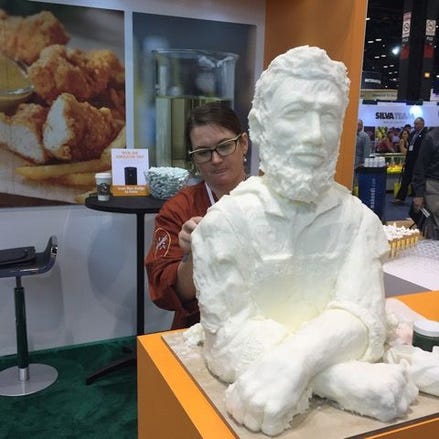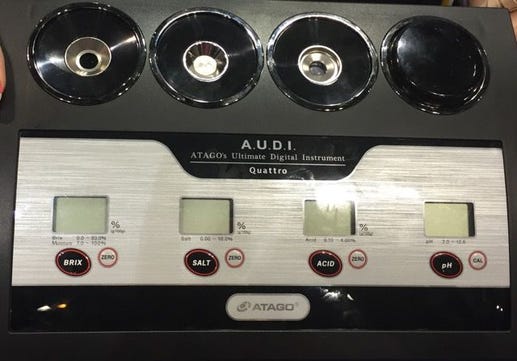Clean Label Really is the New Norm
The real ongoing theme of this year’s IFT was every food scientist’s favorite (and least favorite) topic—clean label. As a consultant who develops food products for both entrepreneurs and large companies, I get frustrated when I am forbidden from using a top-notch functional ingredient because my client does not understand what it means.
July 26, 2016

Another IFT has come and gone—as I get older my trade show navigation skills have improved! This year I noticed all the long-timer booths (like David Michael, Kerry and Tate & Lyle) were located in the same spots on the McCormick floor as last year. I also am really good at finding the best freebie giveaways like the illuminated egg from Okaloosa, the beautiful green T-shirt from the honey board and flashing bracelets from Qualisoy. I should also mention that Qualisoy had a talented artist mold a head out of shortening. Not everyone may have caught this because it was way in the 4000s aisle!

However, the real ongoing theme of this year’s IFT was every food scientist’s favorite (and least favorite) topic—clean label. As a consultant who develops food products for both entrepreneurs and large companies, I get frustrated when I am forbidden from using a top-notch functional ingredient because my client does not understand what it means, and replace it with something that kinda works, but maybe not as well, but comes with a word that is known to mere mortals (aka non-food scientists). Luckily, I have ingredient trade shows like IFT and SupplySide West that give me the opportunity to explore and interact with the latest and greatest clean-label functional ingredients that I can then introduce to my mortal clients who understand what the word means, and in turn put it on the “OK to use" list.
Ingredient trade shows link me up with the best clean-label alternatives out there. For example, every time I make a dry powder mix (protein shakes, fruit powder sport drinks, pancake mix, cake mix) I need anti-caking agents. The most popular anti-caking agent is silicone dioxide. The scientists of the world know that silicone comes from quartz and oxygen comes from the earth. It’s as natural as can be, but to the uninformed mortals they are just eating “chemicals." Well in comes Ribose, a leading organic, natural clean-label rice-based alternative. Its Nu-Flow anti-caking agent can be used to replace SiO2 or the even dirtier “tri-calcium phosphate" (oh no, not CALCIUM!) with simple “rice concentrate." Boom! Done! Everyone is happy! I feel safe in knowing my dry blend won’t clump and my clients can breathe a sign of relief that no nasty chemicals that will offend their clients will be on their ingredient statement. It’s a win-win situation.
Phosphates are very common in the cured meat in industry and are used to retain moisture and maintain flavor. They increase the water holding capacity of meat by forcing proteins apart, allowing water to move in between the protein molecules. Most people don’t really know what this word means or how it functions—they don’t want to see it on the label. Luckily, I found Prosur’s PRS PHR, an innovative clean-label solution made out of yeast extracts (Saccharomyces Cerevisiae, Pichia Jadinii) and citrus extracts. They have a synergistic effect on the solubilization capacity of actomyosine, which boosts the water retention of meat in a more natural way. In layman’s terms—this works like a phosphate and translates to an ingredient statement that says: yeast extract, citrus extract. To the consumer, yeast and citrus are clean while phosphates are not.
TIC Gums is a leader when it comes to clean-label ingredients. Why? First of all, gums were never really unclean to begin with and many have been used for hundreds of years and everyone knows that if our grandmother used it then it must be clean. Let’s face it, most people don’t have food science grandmothers. TIC has a great clean-label hydrocolloid chart reminding food scientists like myself that high methoxyl pectin can simply be called pectin and locust bean gum can be called carob gum. (The hippies in the 60s ate carob instead of chocolate so it must be clean.) High acyl gellen gum can be called just gellen gum. Some gums are organic, which translates scary sounding inulin to organic agave or chicory. There is lots of confusion out there in gum world, and TIC is there to help us legally relay the truth to the consumer. Unfortunately for ingredients like sodium alginate (aka seaweed) there is no clean label so it is up to the manufacturer to educate their consumer that it is seaweed, organic compliant, non-GMO compliant and on the published whole foods compliance list.
All these companies and more will be exhibiting their functional and clean-label alternative solutions to the food scientists who will be attending SupplySide West. I started checking out SupplySide several years ago and wasn’t quite sure if it was just herbs, supplements or an up and coming IFT-type show. However, each year, more and more ingredient companies are exhibiting at SupplySide, and the show is almost beginning to outgrow the expo hall in Mandalay Bay. In the past I didn’t attend SupplySide very often because I felt it was very supplement and vitamin oriented, but now it’s one of my regular trade shows because of its staple of functional food and beverage ingredient suppliers. I love that it is in Las Vegas too—lots of affordable hotels, great restaurants and nighttime entertainment.
At this year’s IFT there was an eye-opening consumer panel titled “A Clean-Label Revolution." Random consumers from outside the food industry were actually on the stage and sharing their thoughts and feelings about ingredient statements and what they would and would not use. The message was clear—if consumers don’t know what it means or if there is unexplained fear monger attention surrounding it (like carrageenan or GMO’) then they don’t want to buy it.
Clean label is no longer just a thing for the Whole Foods and artisan crowd—it’s becoming an a demand from the everyday consumer, and the food industry needs to start doing a better job of educating the masses on what sodium chloride is and the differences between high fructose corn syrup (HFCS) and corn syrup, or come up with some new functional alternatives with recognizable names.
This is what happens when the food industry pretends like our food was made by friendly green giants and Keebler elves for the last 100 years—consumers eventually find out that it was made in stainless steel tanks in a factory by scientists and engineers. Yes, consumers now know the truth—that food is made in a scientific and methodical way in clean sanitary plants by people that wear hairnets and practice good manufacturing practices (GMPs). It’s time to educate, inform and fix it so we can continue to take advantage of past and future food science contributions to the functional ingredient world.
Aside from clean label, I saw some cool ne things at IFT. One was a new competitor to Genesis, a less-expensive spreadsheet software program for nutritional analysis called Formulator. I was also intrigued by an edible vitamin cup from DSM and Loliware, as well as an edible food wrap film from Monosol that is a transparent, odorless and tasteless film that is biodegradable, dissolves in water and reduces environmental waste. There also was a freeze-dried, high-antioxidant purple corn from Suntava that was used to make energy bars I ate for breakfast during the show. In the equipment world, it was all about recording results with the bluetooth pH meter from Hanna instruments. This is on my food science consultant wish list along with a unit from Atago that measures salt, acid, pH and brix all on the same unit. The Atago unit isn’t on the market yet, but I can’t wait for this to come out because it’s a must-have for any laboratory.

Rachel Zemser, CFS, CCS, is a certified food scientist and independent consultant in the San Francisco Bay Area. A corporate food scientist turned consultant, she helps entrepreneurs understand the ins and outs of the food industry and provides the technical assistance they need in bringing their product to market. A trade show junkie, she attends as many ingredient shows as possible to ensure she is always up to speed on innovative flavor trends and ingredients. She can be reached at [email protected].
Interested in learning more about clean label at SupplySide West this year? There will be a full-day immersive event on Wednesday, Oct. 5 around “Delivering on the Clean Label Expectation." The event is getting lots of buzz and you can check out the agenda and speaker lineup here.
About the Author
You May Also Like